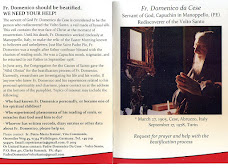.JPG)
A selection from the book by Saverio Gaeta L'Altra Sindone, La Vera Storia del Volto di Gesu' (The Other Shroud, the True Story of the Face of Jesus) Mondadori, Milan, 2005.
On May 13, 1373 the blessed Julian of Norwich, a devout Englishwoman, obtained what she had been asking in prayer for a long time: “To be really present with the Magdalen and the other friends of Christ to be able to see with my own eyes the passion that our Lord suffered for me, and thus to be able to suffer with him, as was given to those who loved him and were alongside him... A bodily vision in which I would be able to have a greater knowledge of the physical suffering of our Savior and of the compassion of Our Lady and of all his faithful friends who were alive at that time and thus saw his suffering”.
Julian, who spent at least the last twenty years of her life as a cloistered nun, compiled a manuscript with the recounting of the sixteen revelations which she had received, subdividing the draft into eighty-six chapters. The tenth narrates the second revelation and it is of great interest for us because it deals with among other things, as states the summary added by a compiler, “of our redemption and of the fading of the veil of Veronica”. After having pointed to the “brutal and dark death that our blessed Lord, beautiful and splendorous, suffered for our sins”, the visionary recounts that there came to her mind “the Holy Handkerchief at Rome on which he imprinted his own blessed features at the time of his cruel passion, for when he was going willingly to death he suffered much change of colour. Many people are surprised that his likeness should be brown and black, downcast and wan, since he who imprinted on it his blessed face is the fairest of heaven, the flower of the earth, and the fruit of the maiden’s womb. How then could this likeness be so pale and so unbeautiful?”
Incisively Julian continues, “In truth I dare to say, and all must believe, that there was never a man as beautiful as he, up until the moment in which the beautiful color of his flesh was changed by his toil and suffering, by his passion and death. Of this one speaks in the eighth revelation, in the sixteenth chapter, where is described more fully of this image. And there it says that the face imprinted on the veil of Veronica that is found in Rome, changes in color and appearance, appearing at times alive and consoling, at other times more afflicted and as one who is dead, so that all are able to see”. The plasticity of the images that are proposed by Julian in the sixteenth chapter call to mind the various photographs of the Face of Manoppello, according to the light that falls upon the veil and the position from which it is observed. “I saw the sweet face as if dray and pale, with the ashen color of the dead, and then deadly pallid, while he was failing and then as violet and then yellowish, little by little as death entered more profoundly in his flesh. His passion manifested itself to me more distinctively on his blessed face, and in particular on his lips. There I saw the four colors which I have described”.
Here several sections of Blessed Julian's Revelations of Divine Love are quoted which describe her mystical visions of the Veil of Veronica. Blessed Julian lived from 1342 until approximately 1417 and is considered the most important mystic of English origin. Her voice and prayers will surely be a help in this common effort to know the Face of Christ. As Saverio Gaeta highlights, The plasticity of the images that are proposed by Julian in the sixteenth chapter call to mind the various photographs of the Face of Manoppello, according to the light that falls upon the veil and the position from which it is observed.





No comments:
Post a Comment